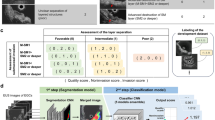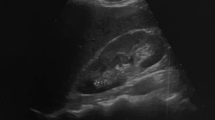Abstract
The aim of this study was to develop a CT-based radiomics and clinical variable diagnostic model for the preoperative prediction of uric acid calculi. In this retrospective study, 370 patients with urolithiasis who underwent preoperative urinary CT scans were enrolled. The CT images of each patient were manually segmented, and radiomics features were extracted. Sixteen radiomics features were selected by one-way analysis of variance (ANOVA) and least absolute shrinkage and selection operator (LASSO). Logistic regression (LR), random forest (RF) and support vector machine (SVM) were used to model the selected features, and the model with the best performance was selected. Multivariate logistic regression was used to screen out significant clinical variables, and the radiomics features and clinical variables were combined to construct a nomogram model. The area under the receiver operating characteristic (ROC) curve (AUC), etc., were used to evaluate the diagnostic performance of the model. Among the three machine learning models, the LR model had the best performance and good robustness of the dataset. Therefore, the LR model was used to construct the nomogram. The AUCs of the nomogram model in the training set and validation set were 0.878 and 0.867, respectively, which were significantly higher than those of the radiomics model and the clinical feature model. The CT-based radiomics model based has good performance in distinguishing uric acid stones from nonuric acid stones, and the nomogram model has the best diagnostic performance among the three models. This model can provide an effective reference for clinical decision-making.







Similar content being viewed by others
Availability of data and materials
Data available on request from the authors.
References
Ma Q, Fang L, Su R, Ma L, Xie G, Cheng Y (2018) Uric acid stones, clinical manifestations and therapeutic considerations. Postgrad Med J 94:458–462
Hall PM (2009) Nephrolithiasis: treatment, causes, and prevention. Cleveland Clin J Med 76:583–591
Sakhaee K (2014) Epidemiology and clinical pathophysiology of uric acid kidney stones. J Nephrol 27:241–245
Liu CJ, Wu JS, Huang HS (2019) Decreased associated risk of gout in diabetes patients with uric acid urolithiasis. J Clin Med 8:2
Lee S, Choi KB, Kim SJ (2020) The effect of uric acid and urinary sodium excretion on prehypertension: a nationwide population-based study. BMC Cardiovasc Disord 20:251
Abou-Elela A (2017) Epidemiology, pathophysiology, and management of uric acid urolithiasis: a narrative review. J Adv Res 8:513–527
Tsaturyan A, Bokova E, Bosshard P, Bonny O, Fuster DG, Roth B (2020) Oral chemolysis is an effective, non-invasive therapy for urinary stones suspected of uric acid content. Urolithiasis 48:501–507
Spek A, Strittmatter F, Graser A, Kufer P, Stief C, Staehler M (2016) Dual energy can accurately differentiate uric acid-containing urinary calculi from calcium stones. World J Urol 34:1297–1302
McGrath TA, Frank RA, Schieda N, Blew B, Salameh JP, Bossuyt PMM et al (2020) Diagnostic accuracy of dual-energy computed tomography (DECT) to differentiate uric acid from non-uric acid calculi: systematic review and meta-analysis. Eur Radiol 30:2791–2801
Lambin P, Leijenaar RTH, Deist TM, Peerlings J, de Jong EEC, van Timmeren J et al (2017) Radiomics: the bridge between medical imaging and personalized medicine. Nat Rev Clin Oncol 14:749–762
Lambin P, Rios-Velazquez E, Leijenaar R, Carvalho S, van Stiphout RG, Granton P et al (2012) Radiomics: extracting more information from medical images using advanced feature analysis. Eur J Cancer 48:441–446
Liu Z, Wang S, Dong D, Wei J, Fang C, Zhou X et al (2019) The applications of radiomics in precision diagnosis and treatment of oncology: opportunities and challenges. Theranostics 9:1303–1322
Yang J, Wu Q, Xu L, Wang Z, Su K, Liu R et al (2020) Integrating tumor and nodal radiomics to predict lymph node metastasis in gastric cancer. Radiotherapy Oncol 150:89–96
Chetan MR, Gleeson FV (2021) Radiomics in predicting treatment response in non-small-cell lung cancer: current status, challenges and future perspectives. Eur Radiol 31:1049–1058
Xi IL, Zhao Y, Wang R, Chang M, Purkayastha S, Chang K et al (2020) Deep learning to distinguish benign from malignant renal lesions based on routine MR imaging. Clin Cancer Res 26:1944–1952
Stanzione A, Gambardella M, Cuocolo R, Ponsiglione A, Romeo V, Imbriaco M (2020) Prostate MRI radiomics: a systematic review and radiomic quality score assessment. Eur J Radiol 129:109095
Xu S, Yao Q, Liu G, Jin D, Chen H, Xu J et al (2020) Combining DWI radiomics features with transurethral resection promotes the differentiation between muscle-invasive bladder cancer and non-muscle-invasive bladder cancer. Eur Radiol 30:1804–1812
Suarez-Ibarrola R, Basulto-Martinez M, Heinze A, Gratzke C, Miernik A (2020) Radiomics applications in renal tumor assessment: a comprehensive review of the literature. Cancers 12:2
Ursprung S, Beer L, Bruining A, Woitek R, Stewart GD, Gallagher FA et al (2020) Radiomics of computed tomography and magnetic resonance imaging in renal cell carcinoma-a systematic review and meta-analysis. Eur Radiol 2:2
Nie P, Yang G, Wang Z, Yan L, Miao W, Hao D et al (2019) A CT-based radiomics nomogram for differentiation of renal angiomyolipoma without visible fat from homogeneous clear cell renal cell carcinoma. Eur Radiol 2:2
Zheng J, Yu H, Batur J, Shi Z, Tuerxun A, Abulajiang A et al (2021) A multicenter study to develop a non-invasive radiomic model to identify urinary infection stone in vivo using machine-learning. Kidney Int 100:870–880
Lim EJ, Castellani D, So WZ, Fong KY, Li JQ, Tiong HY et al (2022) Radiomics in urolithiasis: systematic review of current applications, limitations, and future directions. J Clin Med 11:2
Xun Y, Chen M, Liang P, Tripathi P, Deng H, Zhou Z et al (2020) A novel clinical-radiomics model pre-operatively predicted the stone-free rate of flexible ureteroscopy strategy in kidney stone patients. Front Med 7:576925
Tang L, Li W, Zeng X, Wang R, Yang X, Luo G et al (2021) Value of artificial intelligence model based on unenhanced computed tomography of urinary tract for preoperative prediction of calcium oxalate monohydrate stones in vivo. Ann Transl Med 9:1129
Ganesan V, De S, Shkumat N, Marchini G, Monga M (2018) Accurately diagnosing uric acid stones from conventional computerized tomography imaging: development and preliminary assessment of a pixel mapping software. J Urol 199:487–494
Jendeberg J, Thunberg P, Popiolek M, Lidén M (2021) Single-energy CT predicts uric acid stones with accuracy comparable to dual-energy CT-prospective validation of a quantitative method. Eur Radiol 31:5980–5989
Spettel S, Shah P, Sekhar K, Herr A, White MD (2013) Using Hounsfield unit measurement and urine parameters to predict uric acid stones. Urology 82:22–26
Kim JC, Cho KS, Kim DK, Chung DY, Jung HD, Lee JY (2019) Predictors of uric acid stones: mean stone density, stone heterogeneity index, and variation coefficient of stone density by single-energy non-contrast computed tomography and urinary pH. J Clin Med 8:2
Zhang GM, Sun H, Shi B, Xu M, Xue HD, Jin ZY (2018) Uric acid versus non-uric acid urinary stones: differentiation with single energy CT texture analysis. Clin Radiol 73:792–799
Black KM, Law H, Aldoukhi A, Deng J, Ghani KR (2020) Deep learning computer vision algorithm for detecting kidney stone composition. BJU Int 125(6):920–924
Funding
This work was supported by the National Natural Science Foundation of China under grant numbers 81772713 and 81472411.
Author information
Authors and Affiliations
Contributions
ZW, and WJ: study concept and design. ZW, and YC: acquisition of data. ZW: analysis and interpretation of data. ZW, GY, WJ and HN: critical revision of the manuscript and obtained funding. ZW and XW: statistical analysis. All authors contributed to the article and approved the submitted version.
Corresponding authors
Ethics declarations
Conflict of interest
All authors contributed to the article and approved the submitted version. All authors declare no competing interests.
Additional information
Publisher's Note
Springer Nature remains neutral with regard to jurisdictional claims in published maps and institutional affiliations.
Rights and permissions
Springer Nature or its licensor (e.g. a society or other partner) holds exclusive rights to this article under a publishing agreement with the author(s) or other rightsholder(s); author self-archiving of the accepted manuscript version of this article is solely governed by the terms of such publishing agreement and applicable law.
About this article
Cite this article
Wang, Z., Yang, G., Wang, X. et al. A combined model based on CT radiomics and clinical variables to predict uric acid calculi which have a good accuracy. Urolithiasis 51, 37 (2023). https://doi.org/10.1007/s00240-023-01405-x
Received:
Accepted:
Published:
DOI: https://doi.org/10.1007/s00240-023-01405-x




